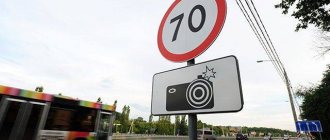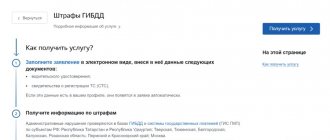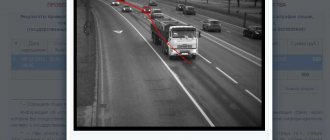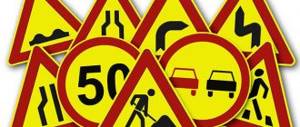How traffic police fines are recorded with photos
How cameras and traffic police officers work. Let's look at the most common case - the camera looks at the lane and records violations: for example, driving into oncoming traffic. As soon as the car is in the oncoming lane, the camera sees that the car is driving against the main flow and takes a series of photographs or video recordings.
After this, the materials are sent to the Center for Automatic Recording of Administrative Offenses (CAFAP), a division of the traffic police. There, the inspector checks from photographs whether the driver really violated and whether the camera made a mistake. If a traffic police officer accepts the driver’s actions as a violation, he signs the resolution and sends it to the traffic police database.
Then the information goes to the information system on state and municipal payments (GIS GMP). This is the information base of the Russian Treasury; it stores all information about payments that have been received or should be received by the treasury. Fines, taxes, penalties from bailiffs - everything is in this database.
Within 3 days, the car owner is sent a decision by mail or he himself checks his fines online and sees a new one.
Why is there not always video recording? The number of photo and video materials and their shelf life depend on the technical equipment of TsAFAP - it is different in each region. For example, in Moscow there is a budget for the purchase and maintenance of large data servers. A server is a powerful computer with a large amount of memory. The more servers, the more opportunities to store photos and videos and do it for a long time. Therefore, in Moscow and the region, even video recordings are stored for up to 3 years.
But if a region has purchased small-volume servers, photos may not be stored for long: in regions this period is often from a week to six months. In this case, the video recording may not be saved at all.
What types of cameras are there? Most often, cameras are installed on supporting structures - poles, overpasses, bridges. There are other ways of arrangement. Let's look at them all:
- stationary - the camera is mounted on a pole or a special mast. Usually located in the city or on busy roads;
- mobile - the camera stands on a tripod. Inspectors install it when they check cars in remote areas of the region - where it is inappropriate to install a stationary camera;
- transportable - the camera is installed on public transport or a special car. This method is almost always used to check whether parking has been paid and whether there are violators in the public transport lane.
Methods of installing cameras: on a pole, tripod, in a special vehicle. Source: simicon.ru
Public transport or special vehicles are equipped with cameras that record violations of parking rules and traffic in designated lanes. Source: simicon.ru
How to appeal a decision
If the owner of the vehicle decides to check the traffic police fines with a photo and look at the photo, but there are no signs of violation in the photo, he can challenge the penalty. Any doubtful cases are considered individually. To do this, you should contact the automatic fixation center. It is recommended to have a printout of the photograph and a protocol on the fine issued with you.
Normally, the TsAFAP department is required to show the driver a video recording that clearly shows the unlawful action. If after this the vehicle owner does not agree with the decision, he can go to court.
In accordance with established standards, car owners are required to pay fines for violations recorded on automatic cameras. To make sure that the punishment is fair, the driver has the opportunity to use one of the offered services and look at photographs that show non-compliance with traffic rules.
Why is photographic recording of the violation necessary?
The camera can monitor the traffic situation 24 hours a day all year round. The inspector does not notice many violations while drawing up a protocol, warming up in the car or having lunch. Here are some more reasons to use cameras.
Objective recording of violations. The camera records what appears to be a violation. Whether this was actually a violation is decided by the traffic police officer. He will look at all available materials and make a decision. If there is still a violation of the rules, the inspector will issue a fine.
Ability to control more roads. The camera can be placed on remote sections of roads with extreme weather conditions.
Recording several violations at once. All traffic cameras have this function. For example, cameras of the Cordon model can simultaneously detect:
- over speed;
- driving into the oncoming lane or tram tracks in the opposite direction;
- driving on the median;
- driving in the public transport lane;
- driving on the side of the road;
- driving trucks where prohibited;
- passing through the stop line.
Makes it easier to find violators and bring them to justice. There are cameras that are configured to search for specific cars by license plate number. The traffic police patrol uses them to track the movement of the offender’s car.
The opportunity to prove your innocence. The inspector rarely looks at all the photos, much less the video from the camera: he doesn’t have time for that. And sometimes the camera makes mistakes - it incorrectly measures the speed or calculates the license plate number of the car.
The camera sends a series of photos or video recordings to the server. If the camera or inspector makes a mistake, the driver can request the entire series of photos or videos that show the mistake and prove his innocence.
What violations are recorded by cameras?
The capabilities of the camera depend on the customer of the equipment - the city administration. If the area is hazardous or several traffic rules are violated at once, the customer asks to enable one or another function on the camera.
Here is a complete list of violations recorded by traffic cameras:
- driving on red;
- driving in reverse;
- leaving the stop line;
- violation of traffic rules through a railway crossing;
- turning from the second row - failure to comply with the rules of maneuvering;
- driving on the side of the road, sidewalk, bike path;
- over speed;
- driving into the oncoming lane;
- driving in the public transport lane;
- violation of parking rules;
- non-payment of parking;
- not allowing pedestrians to pass;
- violation of transportation of oversized cargo.
In Moscow, from the beginning of 2021, the traffic police began testing cameras that can track violations: unfastened seat belt, lack of compulsory motor liability insurance policy and talking on the phone.
Features of the automatic system
The main task of such technologies is to increase the level of safety on the roads and identify persons who do not comply with traffic rules. Complex technical means are used to video record offenses. Cameras capable of recording illegal actions on the road are equipped with intelligent systems. With their help, information about the vehicle that performed the prohibited maneuver is recorded.
The following violations are recorded using automatic means:
- Exceeding permissible speed limits;
- Driving onto the oncoming highway;
- Driving in a lane designated for public transport;
- No license plate;
- Unfastened seat belt.
Cameras can also record other types of illegal actions. In this matter, everything depends on the type of recording device. Typically, automatic systems are installed in areas with the highest vehicle traffic, as well as in areas where the risk of traffic accidents is increased.
Rules for imposing traffic police fines with photo recording
Minimum possible fine. The Code of Administrative Offenses (CAO) often has a range of fines for one violation. For example, for failure to allow a pedestrian to pass, the minimum fine is 1,500, the maximum is 2,500 rubles. If the violation was noticed by a camera and not an inspector, the fine under the Administrative Code will be minimal.
Deadlines for issuing traffic fines with a photo of the violation. The traffic police officer is obliged to make a decision on photo or video materials within 15 days from the day he receives them.
What to do if you receive a fine without a photo
Why do fines arrive without photographs? This happens if the fine comes for violating parking rules. In all regions except Moscow and the Moscow region, there is no photograph in the resolution for this violation. Sometimes a photo does not get into the GIS GMP due to a technical failure. Read more about all the cases when a dubious fine is received in our detailed analysis.
Where to check traffic police fines online with photos. This can be done on the State Services website, but you need to register and confirm your identity, and to do this go to the MFC. Instead, check the fine on the Traffic Police Fines website.
You will need a license plate number, registration certificate and license numbers. Leave your email so you don't miss notifications about new fines.
How to view a photo of a violation
There are several ways to check traffic police fines with photo recording. They are available to absolutely every driver. If traffic rules are violated, the motorist can independently track the presence of an administrative penalty and obtain detailed information.
Official website of the traffic police
Using this online resource, you can find out about the traffic police fine with photo recording and view the photo. From the main page you need to go to the “Services” section and select the “Fine Check” item. To send a request, the driver will need to enter the registration plate and STS number.
It is important to know! After processing, a table will appear on the page reflecting all violations for which you need to pay. There is a “Division” item here, and at the bottom you can select the “Photo” function. If there are captured images, they will appear on the screen.
State Services Portal
On this site, users also have access to checking traffic police fines with photo recording. To find out why a car came to the attention of law enforcement agencies, you must first register.
After authorization, the client should select “Service Catalog” and go to the “Traffic fines” section. To obtain the necessary information, you must enter the license plate number and registration plate. The user has the opportunity to familiarize himself with the presented materials. Thanks to this, he will make sure that the traffic police fine with the photo was issued legally.
Autocode
Using this service, you can check the photo of the fine by the order number. You will also need to enter the numbers from your driver's license or registration certificate.
After processing the request, the user will be able to view information about the violation committed. The corresponding article of the Code of Administrative Offenses will be presented, on the basis of which the driver is found guilty of failure to comply with the law.
Pictures taken by the automatic recording system are also attached here. If necessary, the user is given the opportunity to print photographic material.
Mobile app
Smartphone owners can check photo fines directly on their device. To do this, you need to install a special program on your phone. It is available on all types of operating systems and in the online stores AppStore and PlayMarket.
After the application is downloaded, the driver needs to enter information about the vehicle. As a result, data on current traffic police fines with the order number and photographs from the scene of the violation will appear on the screen. Using the program, you can also quickly deposit funds to pay off the sanctions.
What are the consequences of unpaid traffic police fines with photos?
The case will be handed over to the bailiffs. This will happen 70 days from the date of the decision if the fine is not paid. They give you 10 days to appeal the fine and 60 days to pay. The date can be viewed when checking.
In the upper left corner is the date of the decision, below is the date of violation
The fine will be increased by 1000 rubles. When the FSSP employee receives a copy of the resolution, he will begin enforcement proceedings. A decision about this will be sent to the driver - you can check it at the State Registration Office. If the driver receives a decree and does not pay the fine after 5 days, the bailiff will issue an enforcement fee - 7% of the debt amount, at least 1000 rubles.
Now the driver must pay the fine, plus a fee - he has another 70 days to do this. In this case, you no longer need to pay a fine to the traffic police - only to the bailiffs by their order. This document will also be reflected when checking on the “Fines” website.
For a bailiff's fine, the resolution number begins with the numbers 322
They will withdraw money from the account. This is possible if the driver ignores the order of the bailiffs and does not pay the fine. In this case, the bailiffs refer the case to court. If the debtor does not appear at the meeting, the decision will be made without him, and not in his favor. The judge, after considering the case, can make one of several decisions. Most often, money is forcibly collected from a bank account.
Rights are revoked. This measure can be chosen for the debtor if the debt is more than 10,000 rubles.
Movement will be restricted. Such a sanction may be applied if the debt is more than 30,000 rubles.
They will be arrested or ordered to work. At the meeting, they may be sentenced to 15 days of arrest or forced labor for 50 hours.
Read about all the consequences of failure to pay traffic fines in our other article.
Checking fines from cameras
Fines from the traffic police from video recording cameras often bring problems to vehicle owners.
A notice with copies of documents is sent to the place of registration, but the sending system is far from perfect. Some car owners often do not even realize that a decision has been made against them. At the same time, sanctions accumulate, and if the amount of the debt exceeds 10 thousand rubles, then a forced collection procedure is initiated against the citizen. As a rule, restrictions on movement are introduced and bank accounts are blocked. As a drastic measure, the car owner may receive a ban on transactions with movable property.
To avoid negative consequences, experts recommend checking for sanctions through the official website of the State Traffic Inspectorate or the State Services portal.
Official website of the traffic police
On the fines website from cameras 590 and the official traffic police portal, you can independently check the presence of unpaid receipts. The web resource is automatically linked to a single database, which receives all relevant information about traffic violations.
Step-by-step instructions for checking the resolution from the State Traffic Inspectorate:
- open the “Service” section;
- select the “Check fines” tab;
- enter information in the form that opens about the owner and information about the vehicle;
- get an online report of unpaid invoices.
The service is provided free of charge. You can also make payment on the website. If the system showed the presence of a fine in the database through a video camera, then leaving it unpaid means receiving more severe penalties.
When the owner is sure that he is right, then it is necessary to file a complaint. Compliance with bureaucratic rules of procedure significantly increases the chances of winning a lawsuit in court.
Unified website "State Services"
Information about traffic violations is provided by the State Services website free of charge. To check the current resolution from the State Traffic Inspectorate you should:
- select the “Transport and driving” section
- click on the “Car and traffic fines” tab;
- indicate in the form the information of STS and VU;
- wait for the request to be processed.
When paying on the portal there is a 30% discount.
Using these methods, a citizen can timely receive up-to-date information about the presence of a fine from the camera for speeding and other violations. The average time for receipt of notification is 18-20 days. But due to the complexity of the procedure and possible delivery failures, the use of electronic platforms for verification and payment is more effective and mitigates the negative consequences.
Therefore, you should not wait for the “chain letter” to arrive, but check the unpaid bills yourself. According to Article No. 32.2 of the Code of Administrative Offenses of Russia, the transfer of funds must be made before the expiration of 60 days. Along with this, in the specified article, part No. 1.2. It is stated that when depositing funds within 20 days, a citizen receives a 50% discount.
Read also: Arms Law 2021
It is noteworthy that if the letter is returned to the sender, i.e. to the traffic police, then the notification is considered delivered. Thus, a citizen is obliged to pay sanctions for violating traffic rules.
When can you challenge a traffic police fine with a photo of the violation?
The cameras focus only on the car's registration plate. It happens that the camera makes a mistake, and the traffic police officer does not have time to check the number and compare it with the brand - as a result, the driver receives an erroneous fine. Let's consider such cases.
The owner of the car was not at the scene of the violation. The camera does not see who is driving - the driver could be a company employee who is temporarily using a company car. To prove this, you will need a certificate of employment and testimony from the real driver.
There is another car in the photo. It happens that an attacker puts a fake number on a car - it matches the number of a law-abiding driver. A record from the registrar that the driver was in another place at the time of the violation, for example, on a business trip or at a children’s party, will help prove innocence. Airplane tickets, a certificate from a hotel, or tickets from a performance can help prove innocence. Testimony from witnesses will also be helpful.
There is evidence that there was no violation. For example, the video recorder in the car’s interior recorded that the driver was forced to enter the oncoming lane to avoid an accident.
How to dispute. Write a complaint addressed to the head of the department whose employee made the decision. This must be done within the first 10 days from the date of the decision. If there are DVR recordings, write them down on a flash drive and attach them to the complaint.
The complaint must be considered within 10 days
We wrote more about how to appeal fines from cameras in our other article.
About fines from traffic police cameras
The first video recording cameras only detected whether a car was exceeding the speed limit and were installed at the entrance to populated areas.
In 2021, complexes are located in cities, towns and on public highways. The most controversy arises with the recording of fines by a camera to determine the average speed in a given area. This is due to the fact that there is no such concept in the traffic rules, however, the use of Avtodoria and other complexes is enshrined at the legislative level, as are sanctions against them.
The amount of fines from the traffic police from cameras is established in article No. 12.9 of the Code of Administrative Offenses of the Russian Federation:
- for exceeding the permitted speed by 20-40 km/h - 500 rubles;
- within 40-60 km/h - 1000 rubles;
- in the range of 60-60 km/h - 2500 rubles;
- over 80 km/h - 5000 rub.
Procedure for transferring information from video recording to the database
Traffic violations are read in two ways:
- quick photography;
- video recording.
Simultaneously with the recording process, the equipment scans the vehicle’s license plate number and transmits the information to a single data processing center, i.e., to the database. The procedure itself is carried out online 24/7. The received information is automatically transferred for processing. Errors in software operation are rare. As a rule, determining the car number occurs quickly and as correctly as possible.
An undoubted advantage of using video recording cameras is the absence of the human factor and corruption. The territory of control is additionally expanded, which increases the fight against traffic violations.
Period of receipt of information in the traffic police database
When a violation of traffic rules is recorded by a traffic police inspector, a protocol is drawn up on the spot. The extract and resolution are sent to the owner within three days. With the question of how many days the fines are received from the camera, the situation is more complicated:
- From Art. No. 29.6 of the Code of Administrative Offenses of Russia states that the traffic police have 15 days to consider a case of an offense.
- Based on the results, a resolution is issued indicating the amount of the sanction. Information is published in the unified traffic police database.
- A copy of the documents with a receipt for payment and materials must be sent to the owner of the car within 3 business days from the date of the determination.
Thus, fines for red traffic lights on camera and other traffic violations should be received at the citizen’s address within 18-20 days. The owner of the car is obliged to make payment within 70 days or send a complaint to a higher authority of the traffic police or court within 10 days.
Deadlines for receiving the decision
When a violation of traffic rules is recorded by a traffic police inspector, a protocol is drawn up on the spot. The extract and resolution are sent to the owner within three days. With the question of how many days the fines are received from the camera, the situation is more complicated:
- From Art. No. 29.6 of the Code of Administrative Offenses of Russia states that the traffic police have 15 days to consider a case of an offense.
- Based on the results, a resolution is issued indicating the amount to be paid. Information is published in the unified traffic police database.
- A copy of the documents with a receipt for payment and materials must be sent to the owner of the car within 3 business days from the date of the determination.
Read also: Box “Our Treasure”
Thus, fines for red traffic lights on camera and other traffic violations should be received at the citizen’s address within 18-20 days. The owner of the car is obliged to make payment within 70 days or send a complaint to a higher authority of the traffic police or court within 10 days.
Experts recommend that drivers independently check for unpaid sanctions from the traffic police once a month. This is due to the fact that a letter with copies of documents may arrive late. In such a situation, the opportunity to pay the fine at a discount is lost, and you may also receive a penalty and other negative consequences.
Remember
- Cameras are needed because they work in any weather, around the clock, on any part of the route.
- The camera records specific violations, for example, driving into oncoming traffic. Then the traffic police officer checks from the photo whether there really was a violation. If this is the case, he checks the car number with the owner’s data, signs the resolution and sends the information to the traffic police database.
- If the violation was noticed by the camera and not the inspector, the punishment is lighter. For example, if there is a range of penalties, it is necessary to impose the minimum - a monetary fine instead of deprivation of rights or the minimum of the fines.
- To appeal a fine, collect evidence and attach it to the complaint. The complaint must be submitted to the head of the department whose employee issued the fine.
- If you ignore the fine, the case will be transferred to the FSSP. Bailiffs have the right to withdraw money from a bank account, cancel rights and restrict travel abroad.
- In order not to miss notifications about fines, subscribe to the traffic police fines notifications.
Other articles by the author: Evgeniy Lesnov










